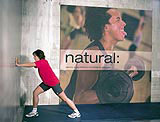Sector in need of toning
Design helped the fitness sector to thrive during its boom years, but as customer numbers wane Richard Clayton thinks it’s time for the sector to shape up

The run-up to Christmas may not be the time most people consider a new regime at the gym. You’re more likely to put that off until the January aftermath. But with their shares tumbling the major health club operators can’t afford to be so complacent. For them, an early dash of New Year resolve wouldn’t go amiss.
The mainstream fitness sector is looking distinctly out of shape. Most of the leading players have issued profit warnings in the past couple of months. Fitness First and Holmes Place are up for sale. LA Fitness chief executive Fred Turock has murmured about joining forces with an out-of-town chain. David Lloyd Leisure, on the verge of confirming Carte Blanche’s interiors brief for more than 30 sites, is touted as a likely candidate (DW 17 October).
SAS partner David Stocks is working alongside Circus on a partial rebrand of LA Fitness. He believes the problem for many health clubs is that their businesses are predicated on commission-driven sales. This means ‘short-term gain for long-term pain’, he says, with high levels of customer ‘churn’ the main result – ‘once people realise their last swim cost [effectively] £200’.
Another factor is that the market expanded rapidly during the 1990s boom years and is suffering now as consumers rein in their discretionary spending. ‘If you go back only a year and a half, the market was incredibly bullish about its growth prospects,’ Stocks adds. ‘Clubs had been pushing at an open door for the past ten years and their chains grew quite aggressively.’
While consumers were sweating out premium rates to pound the treadmills, operators had little incentive to bolster their brands. At boutique-style gyms and spas, design has moved on a pace. But the standard high street product is largely undifferentiated and increasingly out of date.
‘All these clubs look the same,’ Stocks maintains. ‘Pretty terrible design hasn’t stopped people going and improving it would enhance [the environments]. But pumping iron and Jamie Lee Curtis-type aerobics classes are losing their appeal.
‘It’s a very one-dimensional offer, an outmoded and almost 1980s concept. Even new [products] like Pilates are essentially old things repackaged. Design could help from a branding point of view, but it won’t deliver fundamental change. Operators need to think about their offers.’
Stocks says the issue is broader than simply the look and feel of the clubs, their corporate literature, signage and identity. Clinic director Mark Nicholls agrees. His consultancy created the graphical style of Virgin Active, which runs 12 health clubs under its own brand and the Pure Fitness extension. The latest, in Wandsworth, opens on Friday.
Earlier this year, venture capitalist Bridgepoint bought a 55 per cent stake in the company. Since Bridgepoint also owns LivingWell Health and Leisure and has been linked in recent weeks with Holmes Place, Virgin Active may be on to something.
Nicholls says, ‘We began researching the concept of Virgin moving into gyms five years ago [and found] the market had an archaic attitude to customers. People are squeezed at the front end on fees and long-term contracts. Virgin Active wanted to blow a hole in that. Those brands having problems now are the ones still trying to work like that.’
One of Clinic’s main challenges was to make the gym experience feel less intimidating and more family-friendly. ‘Comfort and ambience’ were the watchwords, according to Nicholls, with Watson Design responsible for the interiors (DW 31 May 2001).
‘Clichéd nonsense’ is Nicholls’ description of much health club print and graphics work. ‘You get an attractive girl grinning inanely from an exercise bike and marketing material that says things like New Year, New You. The big gap in the market is for operators that are prepared to talk to people in their own terms. It’s about making the offer more accessible and recognising that customers come in all shapes and sizes,’ he says.
Virgin Active sports ‘real people’ rather than posed models in its posters, says Nicholls. Explanatory health information is available throughout Virgin Active clubs. ‘It’s not rammed into a leaflet holder in the corner,’ he adds.
Stocks takes up the theme. ‘Health clubs have to get closer to what real people and real lifestyles are like,’ he says. ‘What do people need in their lives? It’s not about looking like Caprice and having the fitness of Jonathan Edwards before you go into the club. With stressful lives, people want to feel good and relax, not be criticised by an instructor for missing last week’s session.’
The roll-out of David Lloyd sites and the extent of LA Fitness’ revamp should give pointers as to how the market will develop. Analysts suggest larger scale, family-oriented out-of-town clubs may go hand in hand with no-frills, urban gyms, rather like the way supermarkets have evolved.
That doesn’t sound like an ideal recipe for the life/ work balance though, which Stocks feels health clubs should be advocating. In his view, the sector needs an exercise in self-examination before design can help with reconditioning. It’s enough to make you run to the council swimming baths.
-
Post a comment




